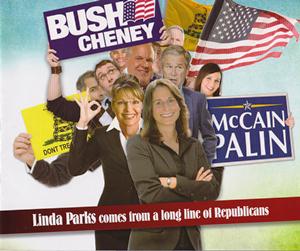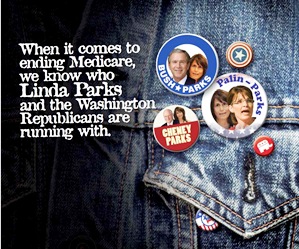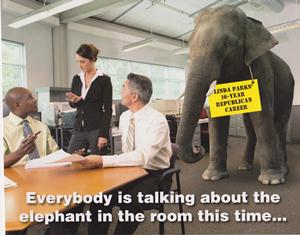
For the first time in a generation, a competitive congressional race is brewing in my Ventura County, CA district. This series explores the local, statewide and national implications of a campaign that was born of voter discontent and might just wind up transforming Congress, and our politics in general. I outlined the parameters of the race here; a few weeks ago I interviewed the independent candidate, Linda Parks, who is starting to gain national attention for her quixotic quest; and last week I covered the single debate that will feature all six candidates in advance of the June 5 primary, exploring the ways in which such events bring out the best and worst in our politicians, and in our politics in general.
Like a lot of Americans, I never know what to do with political mailers. They’re printed in color on glossy paper, and cut in unusual sizes and shapes designed to make sure we pay attention to them. Occasionally they feature pleasant images of a candidate with her family, or with constituents who symbolize the campaign’s priorities (teachers, firefighters, veterans, nurses, minorities, generalized white people, etc.), and they feature upbeat messages like ”Family First” or ”Championing Education.” More often, though, they feature menacing or cartoonish images of an opponent, along with phrases intended to sow doubt or disgust — ”Not Who She Says She Is,” or ”We Just Can’t Trust Her.” Many times, it’s difficult to tell exactly who has sent a particular mailer — it’s amazing how tiny the print can get on a return address or a disclaimer. Always, these mailers are sent in hopes of changing somebody’s mind — if not in my household, then somewhere on my street or in my ZIP code.
Every time, though, I find myself asking the same question many Americans ask when such a mailer appears in the post: Does it belong in the wastebasket, or the recycling bin?
 Campaign mailers have become a daily fact of life for registered Democrats in California’s brand-new 26th congressional district … my district in Ventura County, northwest of Los Angeles. Republicans are enjoying a mild spring here, with seasonal temperatures and a low volume of postal deliveries — primarily because there’s only one of them running for our open seat, a down-the-line conservative named Tony Strickland, and he’s expected to sail through the June 5 primary and into the general election. Democrats, on the other hand, are in a tizzy at the moment. Four of them are on the primary ballot, but the greatest concern for the party establishment is not that the wrong one might win a chance to oppose Strickland come November. It’s that none of them might get that opportunity.
Campaign mailers have become a daily fact of life for registered Democrats in California’s brand-new 26th congressional district … my district in Ventura County, northwest of Los Angeles. Republicans are enjoying a mild spring here, with seasonal temperatures and a low volume of postal deliveries — primarily because there’s only one of them running for our open seat, a down-the-line conservative named Tony Strickland, and he’s expected to sail through the June 5 primary and into the general election. Democrats, on the other hand, are in a tizzy at the moment. Four of them are on the primary ballot, but the greatest concern for the party establishment is not that the wrong one might win a chance to oppose Strickland come November. It’s that none of them might get that opportunity.
The reason for that is California’s new open-primary system, which awards slots on the general-election ballot to the top two finishers in the primary, regardless of party. There is no guaranteed ”Democratic” or ”Republican” slot in November — and to complicate matters further, as I’ve noted throughout this series, the primary race in the 26th features an independent candidate, county supervisor Linda Parks, who has an excellent chance of surpassing all the Democratic candidates next month and taking that second slot. Last week she even received a high-profile endorsement from the Los Angeles Times, an event that reportedly sent the Democratic establishment reeling.
If Parks reaches the general, the national Democratic Party’s chances of retaking the House in November will take a serious dip. The party’s electoral advantages in California are at a peak this year, thanks to a nonpartisan redistricting that eliminated a number of safe GOP seats — including this one, which now leans Democratic for the first time in, well, forever — and the Democratic Congressional Campaign Committee is counting on the state to spearhead its nationwide effort to close the gap on the Republicans’ 25-seat advantage in the House. Electoral margins this fall are expected to be razor-thin at every level of government, so unless the 26th district turns from ”Red to Blue,” as the DCCC’s nationwide campaign calls itself, Congress probably won’t, either.
 This confluence of circumstances explains why attack ads (and paper cuts) have mounted to absurd levels across the county over the last three weeks. (Two of them appeared in my mailbox on Tuesday alone.) Most of these hatchet jobs are the product of more than $800,000 in outside expenditures by Democratic-affiliated groups, according to columnist Timm Herdt of the Ventura County Star. They’re coming from the DCCC (more than $150,000 to date), the House Majority PAC (about $417,000), the League of Conservation Voters (about $100,000), and a committee called Women Vote! (about $25,000), as well as from the well-heeled campaign of the leading Democratic candidate, Julia Brownley.
This confluence of circumstances explains why attack ads (and paper cuts) have mounted to absurd levels across the county over the last three weeks. (Two of them appeared in my mailbox on Tuesday alone.) Most of these hatchet jobs are the product of more than $800,000 in outside expenditures by Democratic-affiliated groups, according to columnist Timm Herdt of the Ventura County Star. They’re coming from the DCCC (more than $150,000 to date), the House Majority PAC (about $417,000), the League of Conservation Voters (about $100,000), and a committee called Women Vote! (about $25,000), as well as from the well-heeled campaign of the leading Democratic candidate, Julia Brownley.
That total — for a primary! — is not just a record for our little pocket of suburbia, which sent the same congressman to Washington for a quarter-century. It also places the district among the 10 nationwide with the highest PAC and party spending so far in 2012. And the vast majority of that money is being spent with a single goal — to convince the county’s Democrats and left-leaning independents to reject Parks and pull the lever for somebody, anybody, with a ”D” beside her or his name on June 5.
Their strategy centers on one key fact about Parks: Before she changed her voter registration to ”No Party Preference” this February, she was a registered Republican, and had been since she first ran for office in 1994. That fact — and the year that she changed her registration, the year of the Contract With America — has allowed national and local Democrats to link Parks to every Republican villain of the last two decades, from Newt Gingrich to George Bush and Dick Cheney to Sarah Palin and Rush Limbaugh. The most effective of these mailers arrived on Tuesday, referring to Parks’ candidacy as ”the elephant in the room” (get it?) and reprinting her voter registration card from 1996, with its checkmark next to the word ”Republican.” (Never mind that another part of that form notes that Parks previously was registered as a Democrat — she changed her party ID in order to boost her chances of winning election in the conservative city of Thousand Oaks.)
 That was a clever strategy on Parks’ part back then, but the Democrats are using it as a bludgeon against her now. All these ads play to a concern that I stated in my earlier column about Parks, which is that in our current hyper-partisan environment, a Democratic voter must worry that a self-identified independent candidate who’s not explicitly with the party will (at least occasionally) act against it, even if she claims to be neutral and nonpartisan. In the zero-sum political game Washington has been playing the last few years, isn’t an independent as much an enemy as a member of the other party?
That was a clever strategy on Parks’ part back then, but the Democrats are using it as a bludgeon against her now. All these ads play to a concern that I stated in my earlier column about Parks, which is that in our current hyper-partisan environment, a Democratic voter must worry that a self-identified independent candidate who’s not explicitly with the party will (at least occasionally) act against it, even if she claims to be neutral and nonpartisan. In the zero-sum political game Washington has been playing the last few years, isn’t an independent as much an enemy as a member of the other party?
So, yes, there’s a clever and even vaguely truthful strategy behind the $800,000-plus in Democratic attack mailers. But the devil, as always, is in the details — and the problems with the Dems’ strategy begin with the fact that while Parks used to self-identify as a Republican, she rarely has acted like one. Her elected positions, on the Thousand Oaks city council and the county board of supervisors, have been nonpartisan ones — and her most prominent achievements while in office have focused on the sorts of environmental and land-use issues that are dear to liberal hearts and anathema to the pro-development types who embody conservatism at the local level. Parks has long served as a bÁªte noire for those folks … and she returned their enmity by endorsing the Democrat in the most recent local election for the state senate, a race in which the successful Republican candidate was — wait for it — her current GOP opponent, Tony Strickland.
To put it mildly, local Republicans loathe Parks, and she has very little in common with the standard-issue conservative bogeymen — two facts well known to any Ventura County voter who has been paying the slightest attention to local politics over the last decade. But the Democratic Party and PACs’ mailers aren’t targeted to those who pay attention. They’re targeted to low-information voters who tune in only for competitive races at the federal level, and who generally have slept through the GOP’s dominance of local politics over the last decades. It is with those voters — who also tend to be the most likely to consider a moderate independent candidate with high name recognition — that the Dems have the best chance of tarnishing Parks’ reputation and driving down her numbers in the primary.
.jpeg) The broad brush being used to accomplish that tarnishing is Parks’ supposed support for the House GOP agenda, and for the Tea Party. The operative implication is that if Parks was ever a registered Republican, she must wholeheartedly endorse the party’s current policies. ”While Washington Republicans are driving Medicare into the ground, Linda Parks is riding shotgun,” says one mailer that places Parks in a convertible with Bush, Cheney and Palin — with Limbaugh at the wheel. ”A vote for Linda Parks and the national Republicans is a vote for the Tea Party,” says another. (Conversely, an ad from House Majority PAC, this one aimed at independents, accuses ”Politician Linda Parks” (horrors!) of profligate, ”Washington-style spending” — and, more important, of elitism — for supporting an equestrian center in a county that includes a whole lot of horse country.)
The broad brush being used to accomplish that tarnishing is Parks’ supposed support for the House GOP agenda, and for the Tea Party. The operative implication is that if Parks was ever a registered Republican, she must wholeheartedly endorse the party’s current policies. ”While Washington Republicans are driving Medicare into the ground, Linda Parks is riding shotgun,” says one mailer that places Parks in a convertible with Bush, Cheney and Palin — with Limbaugh at the wheel. ”A vote for Linda Parks and the national Republicans is a vote for the Tea Party,” says another. (Conversely, an ad from House Majority PAC, this one aimed at independents, accuses ”Politician Linda Parks” (horrors!) of profligate, ”Washington-style spending” — and, more important, of elitism — for supporting an equestrian center in a county that includes a whole lot of horse country.)
Parks is on the record, repeatedly, as opposing any major revamping of Medicare and as supporting women’s reproductive rights without exception, so the substance of the Democrats’ attacks is disingenuous at best. But it’s pretty much the only chance they’ve got to deflate her local popularity and boost Brownley, a state assemblywoman from Santa Monica who faces charges of carpetbagging because she established residency inside the district just in time to launch her candidacy. Brownley has received the endorsements of most traditionally Democratic special-interest groups, from teachers to environmentalists to Planned Parenthood — yet pro-Brownley advertising is just a minor undertaking to date, compared to the avalanche of attacks on Parks.
Such a ratio of negative to positive ads might be smart strategy in a normal campaign — but national Democrats must have heard by now that Parks has a history of turning such high-expenditure attacks to her own advantage. Two years ago she did just that while defending her (nonpartisan) Board of Supervisors seat against a well-financed, nasty, and highly partisan challenge from Tony Strickland’s wife and political shadow, Audra. That campaign pummeled Parks from the right, but with language remarkably similar to that currently being used to pound her from the left.

Parks, in response, chastised Audra for waging a partisan campaign, cast herself as a martyr in the face of a tidal wave of GOP party and PAC money — and won re-election in a 21-point landslide. She has assumed the same posture this spring, holding up copies of the attack mailers during every debate and public appearance while asking her supporters to make history by rejecting the influence of special-interest money, and there’s no reason to think it won’t work for her again next month. Even if a significant number of individual voters reject Parks because of these ads, Brownley’s association with these distasteful mailers (and with the outside groups that will spend nearly $1 million on them by early June) may well wind up backfiring, and costing her at least as many votes as Parks stands to lose. For example, I’m not entirely sure for whom I’ll be voting on June 5, but I know it won’t be for Brownley.
And what if these attacks on Brownley’s behalf do wind up sinking her own candidacy, rather than Parks’? Here is another sense in which the Democrats’ strategy seems less than completely sound, for if Parks achieves top-two status on June 5 and goes on to face Strickland in November, the party’s options for influencing (or benefiting from) the general election seem rather more bleak than if they had laid off. It would seem that county Democrats’ natural inclination will be to support Parks over Strickland; he will mount the same sort of deep-pocketed, slash-and-burn campaign against her that the Dems are waging now, and if he wins election he’ll indubitably march in lockstep with John Boehner, Paul Ryan et al. Yet the Dems’ current blitzkrieg is no doubt poisoning the well among liberal partisans, many of whom may refuse to pull a lever for Parks in November even if the alternative is much, much worse. And nationally, the deep-pocketed DCCC and liberal-leaning PACs likely will be forced to sit out a general-election race that, even if there’s no Democrat on the ballot, might still prove decisive in determining whether Republicans keep their House majority.
And if Parks manages to win in November, how long will she remember the wrongs being inflicted upon her right now by the Democratic establishment? She told me last month that, should she decide she needs to caucus with one party or the other on Capitol Hill, she’ll base her decision on which party seems more intent upon working across the aisle and dealing honestly with the opposition. It’s hard to imagine that the Democrats’ current behavior will reflect well on them if she finds herself in a position to make such a call.
Still, the die has been cast, at least through June 5. In the meantime, Parks has been surprised with a bit of (unsolicited) outside spending on her own behalf. A group called icPurple, founded by Gateway, Inc. co-founder Ted Waitt and dedicated to promoting independent candidates, has created a 30-second web ad touting Parks that may yet receive television airplay as well. Its message is simple, effective, and more than a bit naive.
[youtube id=”Mb3AMPhetvQ” width=”600″ height=”350″]Sure, mixing red and blue into purple is a nice concept — in the fantasyland of bipartisan compromise, it would happen every day. But in a real world (or, at least, a real congressional district) in which the blue team is walloping the purple with a deluge of paintballs, it’s becoming difficult to see how the spirit of bipartisanship will avoid fading once again to black.





Comments